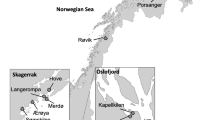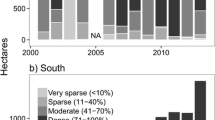Abstract
Eelgrass (Zostera marina) population estimates show a decreasing trend worldwide in the second half of the twentieth century. Mexico lacks long-term time series to determine trends for major eelgrass populations and has made no conservation efforts. Therefore, we present the first report on the historic presence of this annual coastal ecosystem in two wetlands of the Gulf of California (GC), the Infiernillo Channel (CIF, largest Z. marina population inside GC) and Concepcion Bay (BCP, the only eelgrass population along GC’s west coast), combining field surveys (1999–2010), aerial photography (2000–2010), satellite imagery (1972–2005), and published reports (1994–2007). Three parameters were used as indicators of conservation status: shoot density, seed banks, and aerial coverage. Average shoot density in the CIF (741 shoots m−2) was 3.8 times higher than in BCP (194 shoots m−2), and average seed bank density was similar in both wetlands (17,442 seeds m−2 vs. 17,000 seeds m−2). Opportunistic seagrass Ruppia maritima was observed in both wetlands, with higher abundance in summer when Z. marina disappears due to high water temperatures. Eelgrass coverage was three orders of magnitude greater in the CIF (9725 ha) than in BCP (3 ha). The striking difference between these wetlands is the lack of environmental protection for BCP and the protection of the CIF by the Seri indigenous community, which increases human pressure in the former, putting it at high risk of disappearing. Conservation of eelgrass meadows is not only necessary to preserve their ecosystem services but to insure the survival of migratory populations (Pacific brant goose, Branta bernicla), endangered species (Black turtle, Chelonia mydas), and fisheries-related species.


Similar content being viewed by others
References
Aguilar-Rosas R, López-Ruelas J (1985) Halodule wrightii Aschers (Potamogetonales: Cymodoceae) in Topolobampo Bay, Sinaloa, Mexico. Cienc Mar 11:87–91
Brusca RC, Kimrey E, Moore W (2004) A seashore guide to the northern Gulf of California. Arizona-Sonora Desert Museum, Tucson
Den-Hartog C (1970) The seagrasses of the world. North Holland Publishing, Amsterdam
Domning DP (1976) An ecological model for late tertiary sirenian evolution in the North Pacific Ocean. Syst Zool 25:352–362
Duarte CM, Dennison WC, Orth RJ, Carruthers TJB (2008) The charisma of coastal ecosystems: addressing the imbalance. Estuaries Coasts J CERF 31:233–238. doi:10.1007/s12237-008-9038-7
Felger RS, McRoy CP (1975) Seagrass as potential food plants. In: Somers GF (ed) Seedbearing halophytes as food plants. University of Delaware, Newark, pp 62–74
Felger R, Moser MB (1973) Eelgrass (Zostera marina L.) in the Gulf of California: discovery of its nutritional value by the Seri Indians. Science 181:355–356
Felger RS, Moser MB, Moser EW (1980) Seagrasses in Seri Indian culture. In: Phillips RC, McRoy CP (eds) Handbook of seagrass biology: an ecosystem perspective. Garland STPM Press, New York, pp 260–276
Felix-Pico EF (1985) %Cultivo de Argopecten circularis en Baja California Sur, México. 5th International Pectinid Workshop. España, p 12
Fonseca MS, Kenworthy WJ, Thayer GW (1998) Guidelines for the conservation and restoration of seagrasses in the United States and adjacent Waters. In: NsCO Program (Ed.) Decision analysis series no. 12. U.S. Department of Commerce—NOAA, Maryland
Gómez-del-Prado-Rosas MdC, Álvarez-Torres S, Perez-Urbiola JC (1992) Algunos parásitos de almeja “catarina”, Argopecten circularis, en Bahía Concepción, B.C.S., México. Anales del Instituto de Biología Universidad Nacional Autónoma de México Serie Zoología 63:265–271
Green EP, Short FT (2003) World atlas of seagrasses. University of California Press, Berkley
Hinojosa-Arango G, Rioja-Nieto R, Suárez-Castillo AN, Riosmena-Rodríguez R (2014) Using GIS methods to evaluate rhodolith and Sargassum beds as critical habitats for commercially important marine species in Bahía Concepción, B.C.S., México. Cryptogam Algol 35:49–65
Kuo J, den-Hartog C (2001) Seagrass taxonomy and identification key. In: Short FT, Coles RG (eds) Global seagrass research methods. Elsevier, Amsterdam, pp 31–58
Lazar AC, Dawes CJ (1991) A seasonal study of the seagrass Ruppia maritima L. in Tampa Bay, Florida: organic constituents and tolerances to salinity and temperature. Bot Mar 34:265–269
Lee-Long WJ, Coles RG, McKenzie LJ (2000) Issues for seagrass conservation management in Queensland. Pac Conserv Biol 5:321–328
López-Calderón J, Riosmena-Rodríguez R (2011) Nucleador para praderas de pastos marinos. Ondas Internas 15:30–32
Lopez-Calderon J, Martinez A, Gonzalez-Silvera A, Santamaria-del-Angel E, Millan-Nuñez E (2008) Mesoscale eddies and wind variability in the northern Gulf of California. J Geophys Res. doi:10.1029/2007JC004630
Lopez-Calderon J, Riosmena-Rodríguez R, Rodríguez-Baron JM, Carrión-Cortez J, Torre J, Meling-López A, Hinojosa-Arango G, Hernández-Carmona G, García-Hernández J (2010) Outstanding appearance of Ruppia maritima along Baja California Sur, México, and its influence in trophic networks. Mar Biodivers 40:293–300
McMillan C (1983) Seed germination for an annual form of Zostera marina from the Sea of Cortez, Mexico. Aquat Bot 16:105–110
Meling-López AE, Ibarra-Obando SE (1999) Annual life cycles of two Zostera marina L. populations in the Gulf of California: contrasts in seasonality and reproductive effort. Aquat Bot 65:59–69
Moore JE, Colwell A, Mathis RL, Black JM (2004) Staging of Pacific flyway brant in relation to eelgrass abundance and site isolation, with special consideration of Humboldt Bay, California. Biol Conserv 115:475–486
Muñiz-Salazar R, Talbot SL, Sage GK, Ward DH, Cabello-Pasini A (2005) Population genetic structure of annual and perennial populations of Zostera marina L. along the Pacific coast of Baja California and the Gulf of California. Mol Ecol 14:711–722
Nejrup LB, Pedersen MF (2008) Effects of salinity and water temperature on the ecological performance of Zostera marina. Aquat Bot 88:239–246
Nellemann C, Corcoran E, Duarte CM, Valdés L, de Young C, Fonseca L, Grimsditch G (2009) Blue carbon: a rapid response assessment. United Nations Environment Programme. Grid-Arendal. www.grida.no
Olesen B (1999) Reproduction in Danish eelgrass (Zostera marina L.) stands: size-dependence and biomass partitioning. Aquat Bot 65:209–219
Orduña-Rojas J, Riosmena-Rodríguez R (2008) Inventario de la macrofauna marina de interés económico de las islas del norte de Sinaloa, México (Ed.) Sinaloa PFC-. CIDIR Unidad Sinaloa, Guasave, pp 1–36
Ortega MM, Ruiz-Cárdenas J, Oliva-Martínez MG (1986) La vegetación sumergida en la Laguna Agiabampo, Sonora-Sinaloa. An Inst Biol Univ Nal Autón México Ser Bot 57:59–108
Orth RJ, Carruthers TJ, Dennison WC, Duarte CM, Fourqurean JW, Heck KL (2006) A global crisis for seagrass ecosystems. Bioscience 56(12):987–996
Pegau WS, Boss E, Martínez A (2002) Ocean color observations of eddies during the summer in the Gulf of California. Geophys Res Lett. doi:10.1029/2001GL014076
Phillips RC, Menez EG (1988) Seagrasses. Smithson Contrib Mar Sci 34:1–104
Ramírez-García P, Lot A (1994) La distribución del manglar y de los “pastos marinos” en el Golfo de California, México. An Inst Biol Univ Nal Autón México Ser Bot 65:63–72
Rigby PR, Kato T, Riosmena-Rodríguez R (2007) NaGISA seagrass protocol. In: Rigby PR, Iken K, Shirayama Y (eds) Sampling biodiversity in coastal communities: a NaGISA handbook. Kyoto University Press, Kyoto, pp 25–30
Riosmena-Rodríguez R, Sánchez-Lizaso JL (1996) El límite sur de distribución de Zostera marina L. y Phyllospadix torreyi Watson para el noroeste mexicano. Oceánides 11:45–48
Riosmena-Rodríguez R, Muñiz-Salazar R, López-Calderón J, Torre-Cosio J, Meling A, Talbo SL (2013) Conservation status of Zostera marina populations at Mexican Pacific. In: Daniels JA (ed) Advances in environmental research, vol 27. Nova Science Publishers, New York, pp 35–63
Sánchez-Lizaso JL, Riosmena-Rodríguez R (1997) Macroalgas epífitas de Zostera marina L. en Bahía Concepción, B.C.S, México. Oceánides 12:55–59
Santamaría-Gallegos NA (1996) Ciclo de crecimiento y fenología de la fanerógama Zostera marina L. en Punta Arena, Bahía Concepción, B.C.S., México, p 97. Unpublished Master Thesis, Centro Interdisciplinario de Ciencias Marinas, La Paz
Santamaría-Gallegos NA, Sánchez-Lizaso JL, Félix-Pico EF (2000) Phenology and growth cycle of annual subtidal eelgrass in a subtropical locality. Aquat Bot 66:329–339
Schemske DW, Husband BC, Ruckelshaus MH, Goodwillie C, Parker IM, Bishop JG (1994) Evaluating approaches to the conservation of rare and endangered plants. Ecology 75(3):584–606
Short FT, Carruthers TJ, Dennison WC, Waycott M (2007) Global seagrass distribution and diversity: a bioregional model. J Exp Mar Biol Ecol 350:3–20
Short FT, Polidoro B, Livingstone SR, Carpenter KE, Bandeira S, Bujang JS (2011) Extinction risk assessment of the world’s seagrass species. Biol Conserv 144:1961–1971
Song C, Woodcock CE, Seto KC, Lenney MP, Macomber SA (2001) Classification and change detection using Landsat TM data: when and how to correct atmospheric effects? Remote Sens Environ 75:230–244
Torre J (2002) Inventory, monitoring and impact assessment of marine biodiversity in the Seri Indian territory, Gulf of California, Mexico. School of renewable natural resources. The University of Arizona, PhD dissertation, Tucson, p 196
Tripp QA (1985) Explotación y cultivo de la almeja catarina Argopecten circularis en Baja California Sur. Unpublished Master in Science Thesis, CICIMAR, IPN, p 267
Valle M, van Katwijk MM, de Jong DJ, Bouma TJ, Schipper AM, Chust G, Benito BM, Garmendia JM, Borja Á (2013) Comparing the performance of species distribution models of Zostera marina: implications for conservation. J Sea Res 83:56–64
Van Katwijk MM, Bos AR, Kennis P, de Vries R (2010) Vulnerability to eutrophication of a semi-annual life history: a lesson learnt from and extinct eelgrass (Zostera marina) population. Biol Conserv 143(1):248–254
Villalejo-Fuerte M, Ochoa-Báez RI (1993) The reproductive cycle of the scallop Argopecten circularis (Sowerby, 1835) in relation to temperature and photoperiod, in Bahia Concepcion, B.C.S., Mexico. Cien Mar 19:181–202
Ward DH, Reed A, Sedinger JS, Black JM, Derksen DV, Castelli PM (2005) North American Brant: effects of changes in habitat and climate on population dynamics. Glob Chang Biol 11:869–880
Ward DH, Dau CP, Tibbitts TL, Sedinger JS, Anderson BA, Hines JE (2009) Change in abundance of Pacific Brant wintering in Alaska: evidence of a climate warming effect? Arctic 62(3):301–311
Waycott M, Duarte CM, Carruthers TJB, Orth RJ, Dennison WC, Olyarnik S (2009) Accelerating loss of seagrasses across the globe threatens coastal ecosystems. Proc Natl Acad Sci 106(30):12377–12381
Acknowledgments
We wish to thank pilot Sandy Lanham for her support during the CIF aerial surveys in 1999 and 2010 and the Christensen Fund for funding the flights. We also thank the Comcáac community, especially Alfredo López, elder of the Comcáac council. Additionally, we thank Thor Morales for the photographs taken during aerial surveys in 2010, as well as Rafael Segovia, Cathy Marlett, and Steve Marlett for sharing their knowledge on the CIF. JMLC is grateful for support by CONACYT Grant #19923, and Rafael Riosmena-Rodríguez acknowledges the support of CONACYT SEMARNAT Grant #2345.
Author information
Authors and Affiliations
Corresponding author
Additional information
Communicated by Dirk Sven Schmeller.
Rights and permissions
About this article
Cite this article
Lopez-Calderon, J.M., Riosmena-Rodríguez, R., Torre, J. et al. Zostera marina meadows from the Gulf of California: conservation status. Biodivers Conserv 25, 261–273 (2016). https://doi.org/10.1007/s10531-016-1045-6
Received:
Revised:
Accepted:
Published:
Issue Date:
DOI: https://doi.org/10.1007/s10531-016-1045-6




